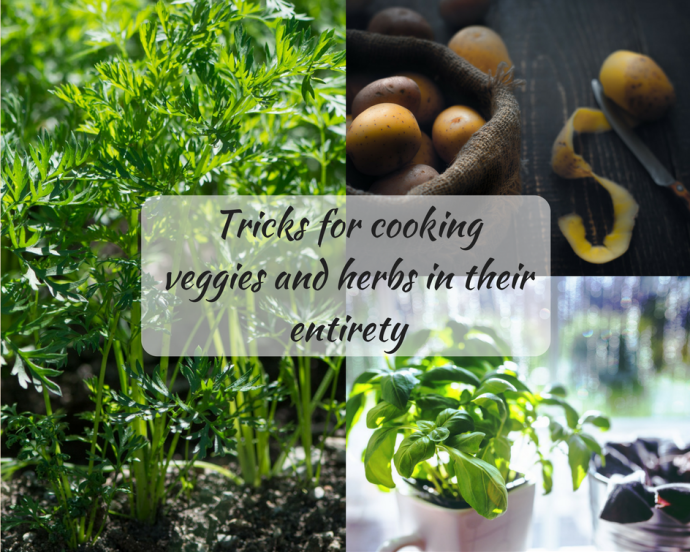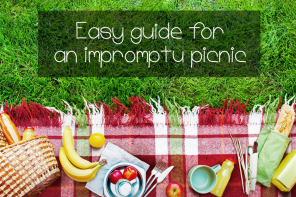Gardening season is coming to an end and you want to benefit fully from your veggies and herbs. Why not reduce waste by using your veggies and herbs completely?
Nothing is lost, everything is transformed – this is the new trend that’s emerging in Western cooking. Global prices of fresh fruits and vegetables is on the rise and people are questioning how they can get the most out of food.
In order to help you save, we’ve made a list of cooking tricks and recipes that will help you use up your veggies and herbs completely. Stop throwing out the peels, leaves, stems and sprigs and start cooking them!
How to cook all parts of a vegetable?

You’re rushed. You’re chopping your favourite veggies and next thing you know, scraps are ending up in the garbage or compost. Here are a few tips on how to reduce vegetable waste and make easy, economical and delicious dishes instead.
What do you do with the tops?
Veggies like carrots, radishes and fennel have a well-kept secret: their tops (leaves). They’re 100% edible and are bursting with vitamins and minerals like potassium.
Young tops from radishes, carrots and beets can be used in salads if they’re fresh and tender, and even in a savoury pesto. Broccoli and cauliflower greens can be used to make soups, cream soups and chowders.
Fennel is bursting with antioxidants and is known to be an excellent cure for tummy troubles. Add new aromas to teas and herbal teas by infusing them with fennel tops. This veggie is very fragrant and smells similar to anise or black licorice which adds a touch of sweetness to your infusions.
Here are a few recipes that work well as sides for gourmets who want to minimize waste:
Can you cook the peels?
Parsnip, potatoes and cucumbers are a veggie peeler’s best friend and it’s easy to add the peels to your weekly menu by using them in original ways. Just scrub them before cooking and you’ll have nutritious ingredients for a ton of recipes.
Chips, fries, tempura and even stuffed, peels are excellent appetizers. You can also add them to homemade soups and broths. It’s a smart way to save on groceries.
Recipes that use vegetable peels:
Oven Baked Parmesan Sweet Potato Skin Fries
How to prepare vegetable stalks and stems?

Mediterranean Cauliflower Stem Soup
We’re used to cutting off vegetable stems and stalks, but with a little creativity, they can impress. Generally eaten raw with dip, veggie stalks like broccoli and cauliflower can be easily integrated into stir-fries, pasta and soups.
Impress your guests with this veggie carpaccio recipe or by making them this broccoli stalk salad. Don’t be afraid to spend time on the presentation and making this “food waste” chic. Experiment with ingredients – they’ll add taste and texture to your dishes.
Recipes that use vegetable stalks:
Mediterranean Cauliflower Stem Soup
Butternut Pumpkin & Cauliflower Stem Soup
Storing and using fresh herbs

Basil, parsley, thyme, rosemary, bay leaves and oregano are the kinds of herbs you want to last. Thanks to these tricks, you’ll be able to enjoy them longer and use them without wasting anything!
How to use herb stems?
Fresh herbs are known for their leaves where all their flavour is, but in the West, people don’t use them. In fact, the stems of most edible herbs can be eaten!
In Asia and India, they use the entire cilantro – roots and all! Change your habits and use fresh cilantro stems and roots to make an easy homemade cilantro paste:
– 4 cilantro roots and stems, finely chopped
– 1 clove garlic
– 1 tsp peppercorns
Put all ingredients in a mortar and make into a paste with a pestle. It’s an excellent little paste that you can add to curries and slow cooker recipes.
Stop throwing away parsley and basil stems. They add freshness to smoothies and juices. You can also use herbs with their leaves to make pistou and pesto.
Pineapple and parsley smoothie
What to do with fresh herb sprigs?
Sprigs in your recipes? Yup! Most fresh herbs like rosemary, thyme, oregano and tarragon have sprigs that can add aroma to your dishes.
Grilling meat in a pan? Put rosemary or thyme sprigs and their leaves in a pan. You’ll have a tastier dish and you’ll save time by not having to remove all the leaves!
An easy trick for cooking sprigs is to use them as skewers for the barbecue. They’ll release their flavour as your skewers grill.
Herb sprigs are also used to make flavoured oils. Just put the sprigs in some olive oil and wait. In a few weeks, you’ll have herb oil. Here’s a recipes to try at home:
Olive oil flavoured with thyme, rosemary and sage leaves
Storing herbs in winter: learn how to take full advantage

1-Herb Butter
Herb butters are trendy and can add a lot of flavour to your recipes. They also last a long time because they can be stored up to six months in the freezer and three weeks in the fridge. Trick: Freeze them in small portions and take only the amount your recipe calls for.
Try whichever herbs you want – the sky’s the limit! The butter will absorb the herb’s aromas and you can enjoy flavoured butter as good as the best bistros and restaurants!
Here’s a practical recipe with a simple method to make your flavoured butters:
2 – Canning
Nothing better than canning your fresh herbs to make them last all winter long! In fact, by following a few recipes, you can store them for several weeks or even months! There are unlimited pesto, pistou and salted herb recipes online. Here are just a few:
Pesto and pistou freeze easily in glass jars or as individual servings in ice cube trays.
3 – Flavoured ice cubes
Freezing isn’t rocket science. It’s a valuable technique to preserve herbs. Just pulse some herb leaves and stems in a food processor with a little water and pour into ice cube trays. They’ll last for several months.
You can also take the leaves of your favourite herbs like mint, basil or cilantro and put them in ice cube trays to flavour your water jug!
Another technique consists of freezing herbs with olive oil. You can brown the ice cube directly in the pan if you need a little fat to cook. Here’s a simple recipe that uses this technique:
Freeze Fresh Herbs in Olive oil
4 – Dried herbs
Why buy dried herbs at the store when you can make them yourself? They’re really easy to do and just require a little patience. Reduce them into powder and put them in containers. This way, you can add them to the dishes you make.
There are many techniques for drying fresh herbs: in the sun, in the oven or in your house. Here is a complete guide of the methods you can use. Choose the one that’s most convenient for you.
5 – Oils
To flavour oils, make sure you’ve crushed the herbs enough to release their delicate fragrance. For optimal results, choose an extra virgin oil that’s fresh. Oils can be kept for several weeks and can even be frozen so they last longer. It’s also an original and practical idea for a birthday gift!
Here’s a little guide for good flavoured oils:
6 – Salts
Salting is an ancient, but effective way to preserve herbs. Salt prevents bacteria from growing, thus prevents herbs from decomposing. You can also make your own herb salts that are excellent in salad dressings and sauces.
To make salted herbs, you’ll need herbs that you’ve already dried or dry your herbs with the salt. Here’s a simple recipe that can be made at home:
7 – Vinegars
How do you use herbs and appreciate their fragrance for as long as possible? By putting them in vinegar! In fact, flavoured vinegars can be kept for several years without changing.
Out-of-the-ordinary cooking: get out of the rut

It’s easy to cook and reduce the amount of food waste: you just have to be creative with your herbs and veggies! Here are a few fun recipes that will surprise your friends and family and help reduce food waste:
Want to reduce your food waste even more? Read our article on how to cook efficiently and avoid wasting.
For foodies who love to read, here are a few interesting books about food waste and cooking without wasting:
“Root-to-Stalk Cooking: The Art of Using the Whole Vegetable”from Tara Duggan
“Root to Leaf: A Southern Chef Cooks Through the Seasons” from Steven Satterfield
Thanks to our simple tricks and recipes, you’ll be able to reduce your food waste considerably while getting the most out of your veggies and fresh herbs. You’ll make delicious dishes that will impress everyone. And how do you not waste veggies and fresh herbs? Share your tricks and recipes with us!









1 Comment